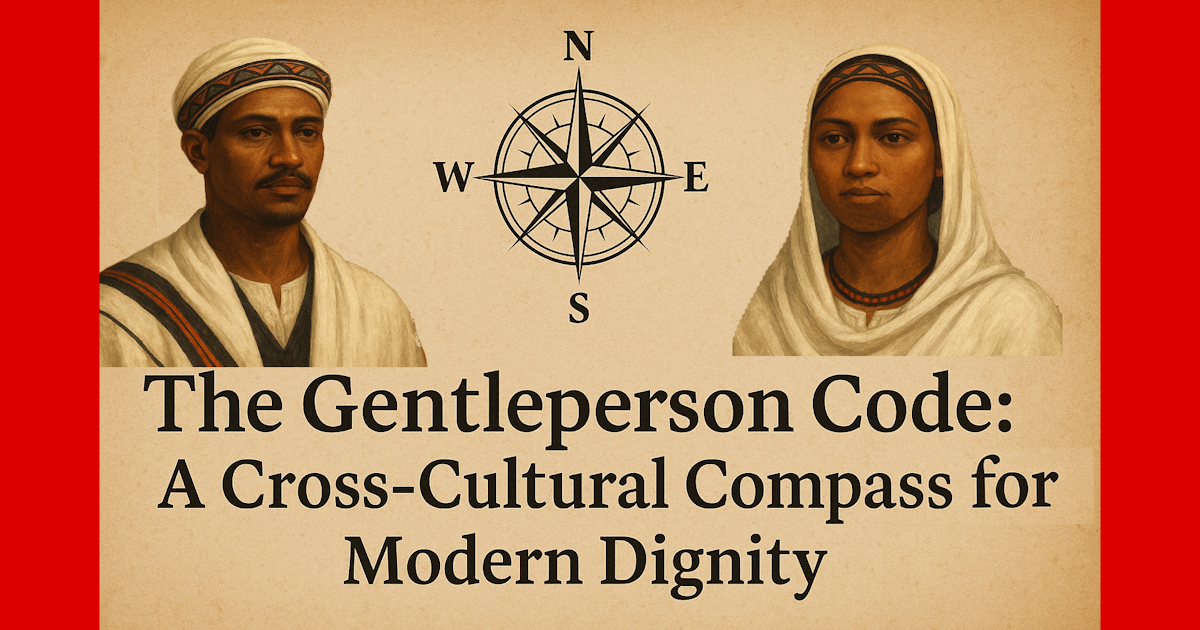The Gentleperson Code: Part I—A Cross-Cultural Compass for Modern Dignity

Excerpt
Across cultures, the gentleperson embodies timeless virtues: respect, integrity, empathy, and self-restraint. More than a gendered label or social rank, a gentleperson is a moral compass in action—graceful under pressure, humble yet firm, protective of others. In today’s noisy world, this quiet strength offers a powerful model of dignity and ethical leadership.
The Rise of the Gentleperson Ideal
In every culture, at every age, there has always been an ideal: a figure who exudes respect, grace, and self-possession. We have known this figure as a “gentleman” or a “gentlelady”—terms rooted in specific social and historical contexts. Yet, in our increasingly interconnected and conscious world, it is time we adopt a more inclusive and essential framing: the gentleperson.
This article proposes that a gentleperson is not defined by class, dress code, or etiquette manuals. Rather, it is a universal archetype—a model of conduct that transcends culture, time, and gender. When stripped of cultural trimmings, such a person is best described not by what they wear, but by what they embody.
The Core Universal Attributes of a Gentleperson
1. Respectfulness
A gentleperson treats others with dignity regardless of social rank, gender, or worldview. This is not mere politeness, but active recognition of the other’s humanity. It manifests in listening attentively, refraining from belittling, and offering others space to speak.
2. Integrity
This is the foundation. A gentleperson says what they mean, keeps their word, and stands by their values even when it’s inconvenient. Truth is not wielded as a weapon but handled with care.
3. Self-Control
Across continents, cultures admire restraint. Whether it’s the East Asian emphasis on harmony or African proverbs about temperance, managing one’s anger, pride, or impulse is a virtue universally admired.
4. Grace Under Pressure
To remain composed when tested, to respond with kindness when provoked—this is the hallmark of inner strength. It’s not detachment; it’s disciplined empathy.
5. Empathy and Generosity
Gentlepersons give—time, assistance, emotional labor—without seeking recognition. Their kindness is not performative. They extend themselves because they understand others’ needs.
6. Humility Without Self-Effacement
A gentleperson knows their worth but does not feel the need to prove it. They raise others instead of hoarding the spotlight. True humility is confident, not apologetic.
7. Protection of the Vulnerable
Whether rooted in medieval chivalry, Oromo Safuu, or Islamic adab, there’s a recurring theme: the gentleperson defends the marginalized, even at personal cost. It’s a quiet courage—often unseen but deeply consequential.
8. Discretion
Not everything must be said. Not every flaw should be exposed. The gentleperson doesn’t gossip, doesn’t betray confidences, and never weaponizes private pain for public gain.
Cross-Cultural Threads of the Gentleperson Ideal
Every society has its own formulation of the ethos for the morally grounded ideal person:
| Culture/Tradition | Ideal | Core Emphasis |
|---|---|---|
| Confucian China | Junzi | Moral refinement, loyalty, respectful speech |
| Oromo | Safuu | Moral boundaries, social dignity, social manners, elder wisdom |
| Japanese | Reigi (礼儀) | Ritualized politeness, duty, self-restraint |
| Islamic/Arab | Adab | Humility, hospitality, honor, spiritual manners |
| British Victorian | Gentleman/Lady | Propriety, discretion, modesty, service |
| West African (Yoruba) | Omoluabi | Integrity, care in speech, respect |
| Indigenous American | Warrior-Peacemaker | Courage, silence when needed, protection of community |
What a Gentleperson Is Not
- Not about class or costume: A tailored suit or a silk scarf doesn’t make you one. It’s about conduct.
- Not performative politeness: Being polite while humiliating others is not gentility—it’s veiled cruelty.
- Not passive: Kindness isn’t weakness. A gentleperson speaks up against injustice but does so with dignity.
The Gentleperson in a World of Noise
Today, amid social noise, outrage culture, and performative virtue-signaling, the gentleperson is a rare but critical figure. They do not seek to dominate discourse. Instead, they speak with purpose, act with intention, and think twice before judging. Such a person is a builder of bridges, not walls. They are the ones who:
- 🧠 Think before reacting
- 🤝 Prioritize empathy over ego
- 🗣 Speak with clarity, not venom
- ⚖ Live with dignity, and extend it to others
In this light, the gentleperson is not an anachronism but a necessity—a human compass in morally confused times.
Let us not lose this ideal to cynicism or cultural relativism. The gentleperson may be rare, but the world aches for their return.
A Personal Challenge
In this chaotic age of digital noise—where voices are loud but often hollow, and where keyboard warriors replace genuine role models—we pose to you a simple yet revealing challenge:
Try to name half a dozen gentlepersons within your own community. Not just those with polished manners, but those whose moral compass you trust, whose actions speak louder than their hashtags, and whose presence uplifts rather than intimidates.
If you’re old enough to span at least two generations, compare your current list with who would have made the cut in your parents’ or grandparents’ time. Are you noticing a trend? Fewer names? Different qualities? More show, less substance?
Such a reflection may prove quietly transformative. In doing so, you’re not only engaging in intergenerational assessment—but in a subtle act of cultural self-audit.
We leave you with that thought as we gear up for Part II—where we explore how the erosion of Safuu, the Oromo inner moral compass, may be at the heart of our gentleperson deficit.
References
- Culture and Positive Psychology, Wikipedia.
- Who is the “Superior Man”? The Ideal of Junzi in The Analects of Confucius, Georgia Southern University, USA.






This article is beautifully written and profoundly relevant, offering a thoughtful reflection on the timeless and universal virtues embodied by the gentleperson ideal. I especially appreciate how it moves beyond outdated, gendered labels and reframes dignity, integrity, and empathy as human qualities essential across cultures and generations. The cross-cultural examples enrich the message, and the inclusion of Safuu in Oromo culture is especially meaningful. Safuu the deep moral code that governs respect, social harmony, and ethical conduct within Oromo society deserves wider recognition, and this article honors its place alongside other global moral philosophies. In an age where outrage often replaces wisdom, the gentleperson ideal, rooted in values like Safuu, offers a critical framework for ethical leadership and quiet courage. The personal challenge at the end is impactful, inviting meaningful self-reflection. Overall, this is a timely, insightful, and restorative piece of writing.